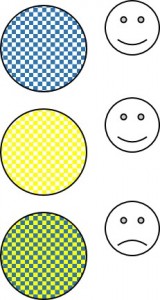As I wrote about in my last post, bees are capable of learning which flowers offer good nectar rewards based on floral features such as colour, smell, shape, texture, pattern, temperature and electric charge. They do this through associative learning: learning that a ‘conditioned stimulus’ (for example, the colour yellow) is associated with an ‘unconditioned stimulus’ (nectar). Learning simple associations like these is the basis of all learning – pretty much all animals do it, from humans to the sea slug which doesn’t even have a brain.
However, the world is rarely as simple as this and so animals need to be flexible. For example, as humans we might learn that if we put our bank card in a machine and enter a pin number we can obtain money. However, we might also have to learn that we can only access the bank machine inside the bank during particular hours, or that if we travel to another country their bank machines might operate differently. Therefore we need some behavioural flexibility around what we’ve learned. The same is true for bees. In a bee’s world, much of what she learns relates to getting food from flowers. However, it won’t always be as simple as ‘blue flowers have better nectar than yellow rewards’. Instead a bee might have to learn ‘blue flowers have better nectar than yellow flowers, but only in the morning’ or ‘this particular species of blue flower which also has a specific smell has better nectar than yellow flowers, but another species of blue flower has worse nectar’.

